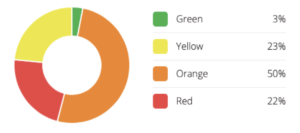The goal of unconscious bias training is to get people to understand that their perspective is informed by their life experiences and that our brains are constructed to find the quickest answer — which means pattern recognition and reliance on stereotypes. In fact, we teach kindergartners by showing them pictures and having them match pictures to concepts. Our adult brains work the same way.
By the time we are adults, this pattern matching has been influenced by our families, our community, the media, etc. Emtrain’s video amplifying pattern matching shows how easily you might be led to the wrong conclusion, even when watching a harmless interaction: Pattern Matching–Black Lives Matter!
OK, I’m Biased. Now what?
As a CultureTech firm, Emtrain has innovated a new dimension in unconscious bias training. We create videos of real-world scenarios showing bias from different perspectives, then ask employees to share their opinions on what they saw. We ask what’s really on their mind, and we give them a channel to share it confidentially. We’re also able to share back the polling results from their colleagues, and from other employees who have taken our training.
We embed three behavioral nudges:
-
- we ask people to think from each of the different perspectives presented in the video
- we ask people to consciously consider their own opinion
- we ask them to observe how their own opinion stacks against their peers
Perhaps, if they’ve come to a different conclusion than most others, they’re an outlier. It could be that they’re oblivious to a particular issue that bothers others. Or that they’re super sensitive. Self-awareness is a critical step.
Teaching Black Lives Matter
A few years ago, we created a lesson on Black Lives Matter for our online training course. We showed a video based upon an 2016 incident in a Silicon Valley company where employees had written “Black Lives Matter” and other employees crossed out “Black” and wrote “All.”
-
- For those interested in the real-world circumstances, you can read a news article here: Zuckerberg Tells Facebook Staff To Stop Crossing Out ‘Black Lives Matter’
- If you’d like to see the video we created, you can view it here: Emtrain | Black Lives Matter!
We asked learners where they thought this situation fell on our Workplace Color Spectrum® behavior scale (green is positive, red is toxic). Because it was in mandatory training, we easily gained a significant mass of responses. The results: 3% of learners thought it was perfectly appropriate, and 22% of learners thought it was toxic and illegal. But the answer isn’t either of those. Crossing out “Black” and replacing it with “All” is problematic and disrespectful, but not illegal. By considering their opinion, and reviewing the total results, and seeing the correct answer, learners gained a new perspective.

We went on to teach:
“Raising social or political issues in the workplace can be tricky. For some workers, these kinds of issues are merely interesting topics to discuss. For others, they are intensely personal—an attack on the idea can be perceived as an attack on them or on a protected group. In this example, the workplace is probably not the right forum to make a statement about the shooting.The writers of the message might be understood to be sending a message about their co-workers or treatment at work. The employee who struck the word “Black” could be understood to be sending a message about the writer’s race or ethnicity.”
We also share back to HR the questions that employees ask within our training course (which get answered by our Emtrain Experts) so they know what their employees might be struggling with. Many of these questions are things that employees feel uncomfortable asking their HR business partners or diversity managers.
For example, the questions and comments we received from the learners about the Black Lives Matter scenario indicated that they were really thinking through what they had seen. These are excerpted here:
-
- “Could the white person have felt attacked by the first writing on the board, too?”
- “Technically, the gentleman that wrote “Black Lives Matter” was the one who engaged in setting up an uncomfortable workplace condition. It wasn’t made better by the gentleman that edited it, however point being that it was actually the first individual that created the issue.”
- “What would be the best course for a manager that walks into a room that has Black Lives Matter on the board. Should it be erased?”
- “How is writing “Black Lives Matter” on a work space board not harassment in some peoples eyes ?”
- “Black lives matter or all lives matter , neither should be written on the board in a workplace. The first group of employees should be held accountable for introducing this message into the work environment.”
We have just updated our Black Lives Matter microlesson to incorporate current events, including mentioning Mr. George Floyd and the protests across the nation. We ask a different set of polling questions, to show the different life perspectives of colleagues in the workplace. We’re making the microlesson free for companies to use. View it here: Black Lives Matter Microlesson
How can HR and Diversity leaders help?
There’s a great opportunity for HR and leadership being more proactive and strategic around managing unconscious bias in their organizations. But the reality is that many HR leaders are still trying to convince leadership to approve implicit bias training that is action oriented and strategic – one that truly makes an impact – and not just fall back on a check the box implicit bias training activity.
We recently launched Emtrain AI, a new platform to help HR teams move the needle by providing data insights and benchmarking. We provide aggregated anonymized employee sentiment to employers so they can understand how their learner population reacts to situations of unconscious bias and begin to mitigate them. We also provide benchmarking to specific indicators of workplace culture health, and to other companies in our client data set, as described in our 2020 Workplace Culture Report
For HR and Diversity leaders who want to impact their organization in a positive and long-term way, we encourage focusing on employee sentiment and identifying the root causes of bias in a measured and benchmarked way. Only by knowing where you stand, having a vision of where you need to go, and having actionable next steps to get there can you truly solve for bias.










